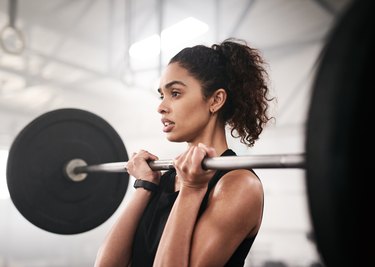
The main differences between a straight bar and curl bar are in their weight, shape and the hand positioning you can utilize when using them for different exercises. These are two of the most common pieces of exercise equipment you will find in a gym that has a resistance training section.
These bars can sometimes be used interchangeably, which is beneficial if the particular bar you want to use or the bar type you want to use is unavailable; however, there are some things to consider when using the bars as substitutes for each other.
Video of the Day
Video of the Day
Tip
The biggest difference between a straight bar and curl bar is their weight.
What They Weigh
Straight bars and curl bars are available is a variety of weights. This is important in determining how much weight you are actually lifting. The total amount is the bar weight added to the amount of plate weights you've mounted on the bar.
An Olympic straight bar typically weighs 45 pounds, but smaller versions are available that weigh 35 lbs. A curl bar usually weighs 25 to 30 pounds. The discrepancy in weight is mainly due to the curl bar being smaller in length than the straight bar.
Difference in Curl Bar Shape
As its name implies, the straight bar, also called a barbell, is a cylindrical rod with a straight shape. On each end of the barbell are two attached rods that are also cylindrical and straight. This is the area of barbell where the weight plates are put on to increase the resistance. The curl bar is smaller in size and has a cambered "W" shape. On each end of the cambered bar are straight rods where the weight plates are added to increase resistance.
Hand Positioning Options
The reason for the difference in the two bars ultimately boils down to how the hands are positioned on the bars. Because a standard barbell is straight, you can assume either an overhand or underhand grip. The angle of your wrists with a standard barbell is straight; however, your wrists are slightly rotated when using a curl bar meaning your wrists will be slightly angled.
A curl bar allows you to grip with an underhand-based "natural" grip with your wrists slightly supinated, or turned out. You can also use an overhand-based "reverse" grip on the curl bar with your wrists slightly pronated, or turned inward.
Read more: Barbell Rows vs. T-Bar Rows
Consider Your Goals
The curl bar is traditionally used for exercises that work smaller muscle groups such as your biceps and triceps. These muscles normally require less weight than exercises that use the straight bar such as the chest and legs. Because the curl bar already weighs less, it makes it possible to select a weight between 25 pounds and 45 pounds when performing exercises that target the smaller muscles.
Also realize that the curl bar has a more natural hand position for exercises that require bending of the elbows. The straight bar increases the amount of torque in the wrists because you must actively hold your wrists in a straight position when they want to naturally turn outward or inward depending on the exercise. This can lead to pain or injury in the wrists if you are unaccustomed to using a straight bar or have poor wrist strength.
Was this article helpful?
150 Characters Max
0/150
Thank you for sharing!
Thank you for your feedback!